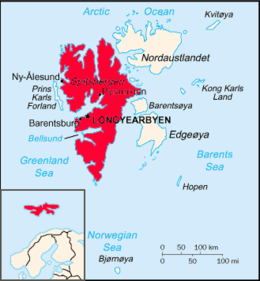
Map of Svalbard with Spitsbergen in the west emphasised
| |
| Geography | |
|---|---|
| Location | Arctic Ocean |
| Coordinates | 78°45′N 16°00′ECoordinates: 78°45′N 16°00′E |
| Archipelago | Svalbard |
| Area | 37,673 km2 (14,546 sq mi) |
| Area rank | 36th |
| Highest elevation | 1,717 m (5,633 ft)[1] |
| Highest point | Newtontoppen |
| Administration | |
| Norway | |
| Largest settlement | Longyearbyen |
| Demographics | |
| Population | 2,642 (2012) |
Spitsbergen (formerly known as West Spitsbergen; Norwegian: Vest Spitsbergen or Vestspitsbergen, also sometimes spelled Spitzbergen)[2][3][4] is the largest and only permanently populated island of the Svalbard archipelago in northern Norway. Constituting the westernmost bulk of the archipelago, it borders the Arctic Ocean, the Norwegian Sea, and the Greenland Sea. Spitsbergen covers an area of 37,673 km2 (14,546 sq mi), making it the largest island in Norway and the 36th-largest in the world. The administrative centre is Longyearbyen. Other settlements, in addition to research outposts, are the Russian mining community of Barentsburg, the research community of Ny-Ålesund, and the mining outpost of Sveagruva. Spitsbergen was covered in 21,977 km2 (8,485 sq mi) of ice in 1999, which was approximately 58.5% of the island's total area.
The island was first used as a whaling base in the 17th and 18th centuries, after which it was abandoned. Coal mining started at the end of the 19th century, and several permanent communities were established. The Svalbard Treaty of 1920 recognized Norwegian sovereignty and established Svalbard as a free economic zone and a demilitarized zone.
The Norwegian Store Norske and the Russian Arktikugol remain the only mining companies. Research and tourism have become important supplementary industries, featuring among others the University Centre in Svalbard and the Svalbard Global Seed Vault. No roads connect the settlements; instead snowmobiles, aircraft, and boats serve as local transport. Svalbard Airport, Longyear provides the main point of entry and exit.
The island has an Arctic climate, although with significantly higher temperatures than other places at the same latitude. The florabenefits from the long period of midnight sun, which compensates for the polar night. Svalbard is a breeding ground for many seabirds, and also supports polar bears, reindeer and marine mammals. Six national parks protect the largely untouched, yet fragile environment. The island has many glaciers, mountains, and fjords.

Keine Kommentare:
Kommentar veröffentlichen